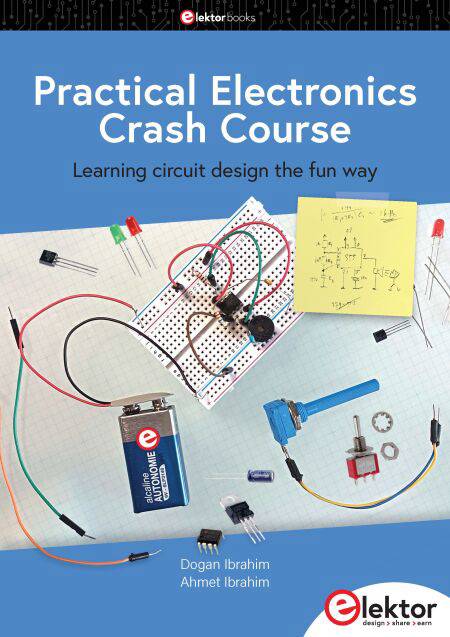
Je cadeautjes zeker op tijd in huis hebben voor de feestdagen? Kom langs in onze winkels en vind het perfecte geschenk!
- Afhalen na 1 uur in een winkel met voorraad
- Gratis thuislevering in België vanaf € 30
- Ruim aanbod met 7 miljoen producten
Je cadeautjes zeker op tijd in huis hebben voor de feestdagen? Kom langs in onze winkels en vind het perfecte geschenk!
- Afhalen na 1 uur in een winkel met voorraad
- Gratis thuislevering in België vanaf € 30
- Ruim aanbod met 7 miljoen producten
Zoeken
Practical Electronics Crash Course E-BOOK
Learning circuit design the fun way
Dogan Ibrahim, Ahmet Ibrahim
E-book | Engels
€ 29,99
+ 29 punten
Uitvoering
Omschrijving
Welcome to the world of electronics!
Getting started in electronics is not as difficult as you may think. Using this book, you will explore and learn the most important electrical and electronics engineering concepts in a fun way by doing various experiments and by simulating circuits. It will teach you electronics practically without getting into complex technical jargon and long calculations. As a result, you will be creating your own projects soon.
No prior knowledge of electronics is required, only some basic algebra is used in a few simple calculations. Many tested and working projects and simulations are presented to familiarise yourself with the construction of electronic circuits. Circuit simulation is introduced at an early stage to enable you to experiment with circuits easily without breaking anything.
You will learn:
> The concepts of voltage, current, and power
> AC and DC
> Basic lamp circuits with switches
> Passive components: resistors, capacitors & inductors
> RC & RCL circuits
> Electromagnetism
> Loudspeakers, relays, buzzers, and transformers
> Active components: diodes & LEDs, bipolar transistors & MOSFETs
> Transistor-based switching circuits
> Optocoupler circuits
> Astable & monostable multivibrators
> Using the 555 timer IC
> The operational amplifier
> Digital logic
> Advanced examples: amplifiers, oscillators, filters, and sensors
> Test and measurement tools
> Microcontrollers: Arduino UNO, ESP32, Raspberry Pi Pico, and Raspberry Pi
> Reading datasheets and best practices for selecting components
> EMC & EMI and norms & regulations
Getting started in electronics is not as difficult as you may think. Using this book, you will explore and learn the most important electrical and electronics engineering concepts in a fun way by doing various experiments and by simulating circuits. It will teach you electronics practically without getting into complex technical jargon and long calculations. As a result, you will be creating your own projects soon.
No prior knowledge of electronics is required, only some basic algebra is used in a few simple calculations. Many tested and working projects and simulations are presented to familiarise yourself with the construction of electronic circuits. Circuit simulation is introduced at an early stage to enable you to experiment with circuits easily without breaking anything.
You will learn:
> The concepts of voltage, current, and power
> AC and DC
> Basic lamp circuits with switches
> Passive components: resistors, capacitors & inductors
> RC & RCL circuits
> Electromagnetism
> Loudspeakers, relays, buzzers, and transformers
> Active components: diodes & LEDs, bipolar transistors & MOSFETs
> Transistor-based switching circuits
> Optocoupler circuits
> Astable & monostable multivibrators
> Using the 555 timer IC
> The operational amplifier
> Digital logic
> Advanced examples: amplifiers, oscillators, filters, and sensors
> Test and measurement tools
> Microcontrollers: Arduino UNO, ESP32, Raspberry Pi Pico, and Raspberry Pi
> Reading datasheets and best practices for selecting components
> EMC & EMI and norms & regulations
Specificaties
Betrokkenen
- Auteur(s):
- Uitgeverij:
Inhoud
- Aantal bladzijden:
- 272
- Taal:
- Engels
Eigenschappen
- Productcode (EAN):
- 9783895766060
- Verschijningsdatum:
- 16/12/2024
- Uitvoering:
- E-book
- Beveiligd met:
- Digital watermarking
- Formaat:

Alleen bij Standaard Boekhandel
+ 29 punten op je klantenkaart van Standaard Boekhandel
Beoordelingen
We publiceren alleen reviews die voldoen aan de voorwaarden voor reviews. Bekijk onze voorwaarden voor reviews.









